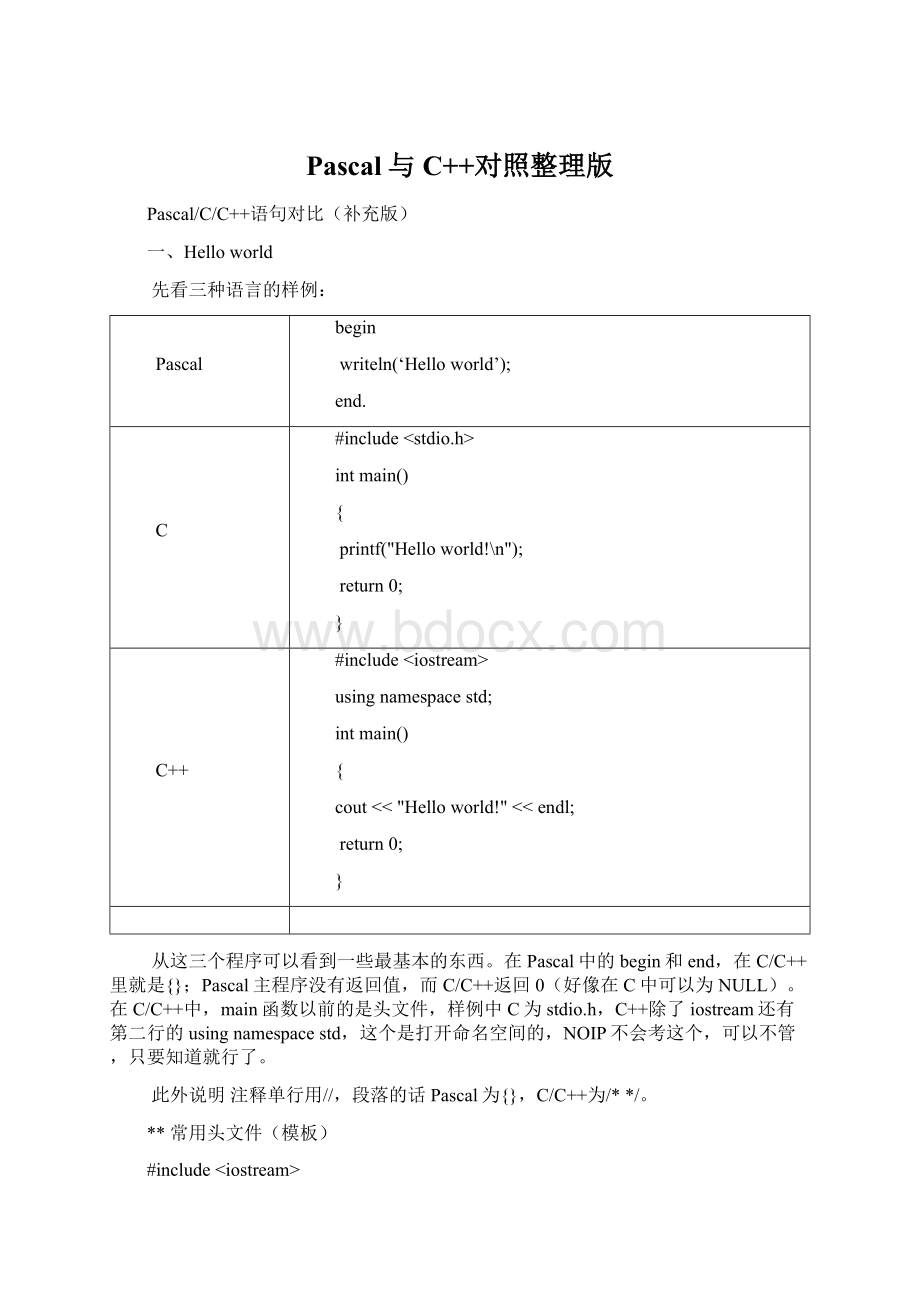Pascal与C++对照整理版.docx
《Pascal与C++对照整理版.docx》由会员分享,可在线阅读,更多相关《Pascal与C++对照整理版.docx(22页珍藏版)》请在冰豆网上搜索。

Pascal与C++对照整理版
Pascal/C/C++语句对比(补充版)
一、Helloworld
先看三种语言的样例:
Pascal
begin
writeln(‘Helloworld’);
end.
C
#include
intmain()
{
printf("Helloworld!
\n");
return0;
}
C++
#include
usingnamespacestd;
intmain()
{
cout<<"Helloworld!
"<return0;
}
从这三个程序可以看到一些最基本的东西。
在Pascal中的begin和end,在C/C++里就是{};Pascal主程序没有返回值,而C/C++返回0(好像在C中可以为NULL)。
在C/C++中,main函数以前的是头文件,样例中C为stdio.h,C++除了iostream还有第二行的usingnamespacestd,这个是打开命名空间的,NOIP不会考这个,可以不管,只要知道就行了。
此外说明注释单行用//,段落的话Pascal为{},C/C++为/**/。
**常用头文件(模板)
#include
#include
#include
#include
#include
#include
usingnamespacestd;
intmain()
{
……
system(“pause”);
return0;
}
二、数据类型及定义
这里只列出常用的类型。
1、整型
Pascal
C/C++
范围
shortint
-
-128…127
integer
short
-32768…32767
longint
Int
-2147483648…2147483647
int64
longlong
-9223372036854775808…9223372036854775807
byte
-
0…255
word
unsignedshort
0…65535
longword
unsignedint
0…4294967295
qword
unsignedlonglong
0…184********709551615
**当对longlong变量赋值时,后要加LL
Longlongx=6327844632743269843LL
**如果位移x<<2LL
**Linux:
printf(“%lld\n”,x);
**Windows:
printf(“%I64d\n”,x);
2、实型
Pascal
C/C++
范围
real
float
2.9E-39…1.7E38
single
-
1.5E-45…3.4E38
double
double
5.0E-324…1.7E308
3、字符即字符串
字符在三种语言中都为char,C里没有字符串,只有用字符数组来代替字符串,Pascal和C++均为string。
Pascal中字符串长度有限制,为255,C++则没有。
字符串和字符在Pascal中均用单引号注明,在C/C++中字符用单引号,字符串用双引号。
4、布尔类型
Pascal中为boolean,C/C++为bool。
值均为True或False。
C/C++中除0外bool都为真。
5、定义
常量的定义均为const,只是在C/C++中必须要注明常量的类型。
在C/C++中还可以用宏来定义常量,此时不注明类型。
Pascal
C/C++
const
a=60;
b=-a+30;
d=‘‘;
constinta=60;
constintb=-a+30;
conststringd=“”;
defineMAXN501//这个是宏
**宏定义其实就是直接在程序相应的位置替换:
#definerandomizesrand(unsignedtime(NULL))
#definewaitfor(intw=0;w<100000;w++)
变量的定义,C/C++在定义的同时可以赋值:
Pascal
C/C++
var
a,b:
integer;
c:
char;
d:
string;
inta,b=50;
charc=‘A’;
stringd;
boolflag;
三、输入输出
C/C++中没有以回车作为结束的读入方式(就本人所知)。
”\n”表示换行。
常规输入输出:
Pascal
C
C++
read(a);//读入变量a
readln(a);//读入变a,回车结束
write(a);//输出a
writeln(a);//输出a并换行
scanf(“%d”,&a);
printf(“%d”,a);
printf(“%d\n”,a);
cin>>a;
cout<cout<特别说明C++中cin一个字符的话会自动跳过空格和回车,Pascal和C则会读入空格和回车。
在Pascal中writeln(a:
n:
m)表示在n个字符宽的输出域上输出a保留m位小数。
例如:
pascalwrite(a:
6)c/c++printf(“%6d”,a)
Pascalwrite(a:
6:
2)c/c++printf(“%6.2f”,a)
C++如果用cout?
(繁琐!
!
)
需要加头文件#inlude
cout<(2)<cout<以下三个进制设定都是永久作用:
cout<cout<cout<例如:
cout<<12<输出:
12c1414
C的输入输出里面的字符串中%表示变量,%后面的字目表示变量类型。
下面是类型表:
%hd
1个short型整数
%d
1个int型整数
%u
1个unsignedint型整数
%I64d
1个longlong型整数
%c
1个字符
%s
1个C字符串
%f
1个float型实数
%lf
1个double型实数
%10.4f
输出1个总宽度为10,保留4位小数的实数
文件输入输出:
Pascal
assign(input,‘test.in’);
assign(output,‘test.out’);
reset(input);
rewrite(output);
read(a,b);
writeln(a,b);
close(input);
close(output);
C
FILE*fin=fopen(“test.in”,“r”);
FILE*fout=fopen(“test.out”,“w”);
fscanf(fin,“%d%d”,&a,&b);
fprintf(fout,“%d%d”,a,b);
fclose(fin);
fclose(fout);
C++
#include
usingnamespacestd;
ifstreamfin(“test.in”);
ofstreamfout(“test.out”);
fin>>a>>b;
fout<fin.close();
fout.close();
因为C++的读入较慢,个人建议C++的话使用C的输入方式。
当然也有人用C的读入,C++的输出的,这种方式我们称之为城乡结合。
**中国计算机学会竞赛须知发布的C读写程序:
(C++也能用,cin,cout,scanf,printf可混用)
#include
intmain()
{
inta,b;
freopen(“sum.in”,”r”,stdin);
freopen(“sum.out”,”w”,stdout);
scanf(“%d%d”,&a,&b);
printf(“%d\n”,a+b);
return0;
}
或者:
freopen(“sum.in”,”r”,stdin);
freopen(“sum.out”,”w”,stdout);
ios:
:
sync_with_stdio(false);\\取消同步,cin,cout的速度就不慢了!
!
cin>>a>>b;
cout<return0;
以下扩充c/c++混用是可行的:
#include
#include
usingnamespacestd;
intmain()
{
inta,b,c,d;
freopen("sum.in","r",stdin);
freopen("sum.out","w",stdout);
scanf("%d%d",&a,&b);
cin>>c>>d;
printf("%d\n",a+b);
cout<return0;
}
**如何判断文件结束(EOF)?
C++
while(cin>>s>>n)
{
...
}
C
while(scanf(%s%d",s,&n)!
=EOF)
{
...
}
四、赋值语句及运算符号
一一对应的关系
Pascal
C/C++
赋值运算
赋值
:
=
=
基本运算
加
+
+
减
-
-
乘
*
*
除(实数)
/
/(double)
除法
取整
div
(int)/(int)
取余
mod
%
比较
等于
=
==
不等于
<>
!
=
大于
>
>
大于等于
>=
>=
小于
<
<
小于等于
<=
<=
逻辑
且
and
&&
或
or
||
非
not
!
位运算
左移(*2)
shl
<<
右移(/2)
shr
>>
且
and
&
或
or
|
非
not
~
异或
xor
^
其他
增一
inc(x)
x++
减一
dec(x)
x--
在C/C++中对某个变量自身进行运算可以简写为
变量名运算符号=改变量
如x+=8就表示x=x+8,即inc(x,8)。
在C/C++里还存在一种三目运算
变量名=条件?
值A:
值B
如x=x>0?
x:
-x;//表示若x>0则取x,否则取–x,
同ifx>0thenx: